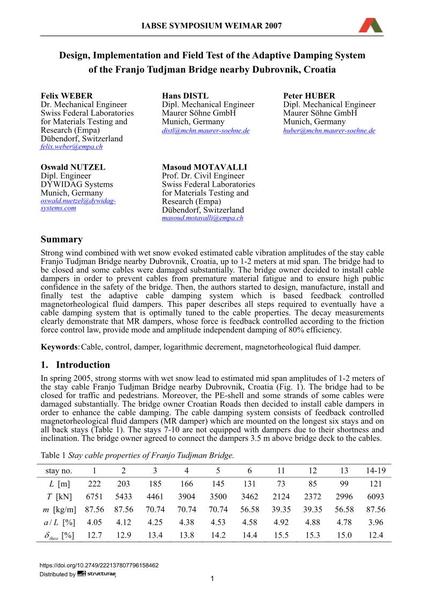Design, Implementation and Field Test of the Adaptive Damping System of the Franjo Tudjman Bridge nearby Dubrovnik, Croatia

|
|
|||||||||||
Bibliografische Angaben
| Autor(en): |
Felix Weber
Hans Distl Peter Huber Oswald Nützel Masoud Motavalli |
||||
|---|---|---|---|---|---|
| Medium: | Tagungsbeitrag | ||||
| Sprache(n): | Englisch | ||||
| Tagung: | IABSE Symposium: Improving Infrastructure Worldwide, Weimar, Germany, 19-21 September 2007 | ||||
| Veröffentlicht in: | IABSE Symposium Weimar 2007 | ||||
|
|||||
| Seite(n): | 414-417 | ||||
| Anzahl der Seiten (im PDF): | 8 | ||||
| Jahr: | 2007 | ||||
| DOI: | 10.2749/222137807796158462 | ||||
| Abstrakt: |
Strong wind combined with wet snow evoked estimated cable vibration amplitudes of the stay cable Franjo Tudjman Bridge nearby Dubrovnik, Croatia, up to 1-2 meters at mid span. The bridge had to be closed and some cables were damaged substantially. The bridge owner decided to install cable dampers in order to prevent cables from premature material fatigue and to ensure high public confidence in the safety of the bridge. Then, the authors started to design, manufacture, install and finally test the adaptive cable damping system which is based feedback controlled magnetorheological fluid dampers. This paper describes all steps required to eventually have a cable damping system that is optimally tuned to the cable properties. The decay measurements clearly demonstrate that MR dampers, whose force is feedback controlled according to the friction force control law, provide mode and amplitude independent damping of 80% efficiency. |
||||
| Stichwörter: |
Seil Dämpfer
|
||||
